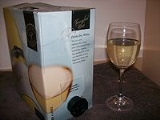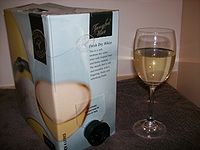
Box wine
Encyclopedia

Wine
Wine is an alcoholic beverage, made of fermented fruit juice, usually from grapes. The natural chemical balance of grapes lets them ferment without the addition of sugars, acids, enzymes, or other nutrients. Grape wine is produced by fermenting crushed grapes using various types of yeast. Yeast...
packaged as a Bag-In-Box
Bag-In-Box
In packaging, a bag-in-box or BiB is a type of container for the storage and transportation of liquids. It consists of a strong bladder , usually made of several layers of metallised film or other plastics, seated inside a corrugated fiberboard box. The bag is supplied to the 'filler' as an empty...
. Such packages contain a plastic
Plastic
A plastic material is any of a wide range of synthetic or semi-synthetic organic solids used in the manufacture of industrial products. Plastics are typically polymers of high molecular mass, and may contain other substances to improve performance and/or reduce production costs...
bladder protected by a box
Box
Box describes a variety of containers and receptacles for permanent use as storage, or for temporary use often for transporting contents. The word derives from the Greek πύξος , "box, boxwood"....
, usually made of corrugated fiberboard.
History
The process for packaging 'cask wine' (box wine) was invented by Thomas Angove of Angove's, a winemaker from RenmarkRenmark, South Australia
Renmark is a town in South Australia's rural Riverland area, and is located 254 km northeast of Adelaide, on the banks of the River Murray. The Sturt Highway between Adelaide and Sydney runs through the town; Renmark is the last major town encountered in South Australia when driving this route. It...
, South Australia
South Australia
South Australia is a state of Australia in the southern central part of the country. It covers some of the most arid parts of the continent; with a total land area of , it is the fourth largest of Australia's six states and two territories.South Australia shares borders with all of the mainland...
, and patented by the company on April 20, 1965. Polyethelene bladders of 1 gallon (3.79 litres) were placed in corrugated boxes for retail sale. The original design required that the consumer cut the corner off the bladder, pour out the serving of wine and then reseal it with a special peg.
In 1967 Charles Henry Malpas and Penfolds
Penfolds
Penfolds is an Australian wine producer, founded in 1844 by Christopher Rawson Penfold, an English physician who emigrated to Australia, and his wife, Mary Penfold...
Wines patented a plastic, air-tight tap
Tap (valve)
A tap is a valve controlling release of liquids or gas. In the British Isles and most of the Commonwealth, the word is used for any everyday type of valve, particularly the fittings that control water supply to bathtubs and sinks. In the U.S., the term "tap" is more often used for beer taps,...
welded to a metallised bladder, making storage more convenient. All modern wine casks now utilise some sort of plastic tap, which is exposed by tearing away a perforated
Perforation
A perforation is a small hole in a thin material or web. There is usually more than one perforation in an organized fashion, where all of the holes are called a perforation...
panel on the box.
Bag in a box packaging is also preferred by producers of less expensive wines because it is cheaper than glass bottles. A bag of wine, removed from the box, will float on water, allowing quick cooling of a white wine by immersion in an ice bath.
The packaging first found commercial success in the land of its invention Australia, and while it has since established a steady market across Europe and South Africa, in the US the boxed wine has found difficulty in overcoming a down-market image.
Pros and cons
Bag-in-box packaging has some advantages over bottles and is preferred by some wineries because it is far less expensive, lighter and more environmentally friendly than bottled wine and far easier to handle and transport. Boxed wine is typically cheaper than bottled varieties, often around A$10 (GBP£6, US$10) for 4 litres in Australia.The primary benefit that bag-in-box packaging offers to consumers is that it prevents oxidation of the wine during dispensing. After opening, wine in a bottle
Bottle
A bottle is a rigid container with a neck that is narrower than the body and a "mouth". By contrast, a jar has a relatively large mouth or opening. Bottles are often made of glass, clay, plastic, aluminum or other impervious materials, and typically used to store liquids such as water, milk, soft...
is oxidised by air in the bottle which has displaced the wine poured. Wine in a bag is not touched by air and thus not subject to oxidation until it is dispensed. Cask wine is not subject to cork taint
Cork taint
Cork taint is a broad term referring to a wine fault characterized by a set of undesirable smells or tastes found in a bottle of wine, especially spoilage that can only be detected after bottling, aging and opening...
or spoilage due to slow consumption after opening and can stay fresh for weeks after opening.
The bag is not hermetically sealed and has an unopened shelf life
Shelf life
Shelf life is the length of time that food, drink, medicine, chemicals, and many other perishable items are given before they are considered unsuitable for sale, use, or consumption...
shorter than bottled wine. Most casks will have a best-before date stamped. As a result, it is not intended for cellaring
Wine cellar
A wine cellar is a storage room for wine in bottles or barrels, or more rarely in carboys, amphorae or plastic containers. In an active wine cellar, important factors such as temperature and humidity are maintained by a climate control system. In contrast, passive wine cellars are not...
and should be drunk within the printed period. Deterioration may be quite noticeable by 12 months after filling.
Manufacturers of 'higher class' bottled wines have complained about the cheapness of 'cask' wines, arguing that they provide a cheap means for alcoholics to become inebriated. In particular, the lower level of alcohol excise levied on cask wine in Australia (compared to beer and bottled wine) has been criticised as encouraging binge drinking. Cask wine in Australia is colloquially referred to as "goon" which is a term derived from the word flagon
Flagon
A flagon is a large leather, metal or ceramic vessel, commonly a pitcher, often used for drink, whether this be water, ale, or something else.-Christian use:...
meaning a large vessel used for drink, or "boxy", in reference to its low price and high alcohol content. Goon is the shortened version.
Box wine has environmental benefits. The bag allows a content of 2–10 litres, so that far less packaging mass is required.

